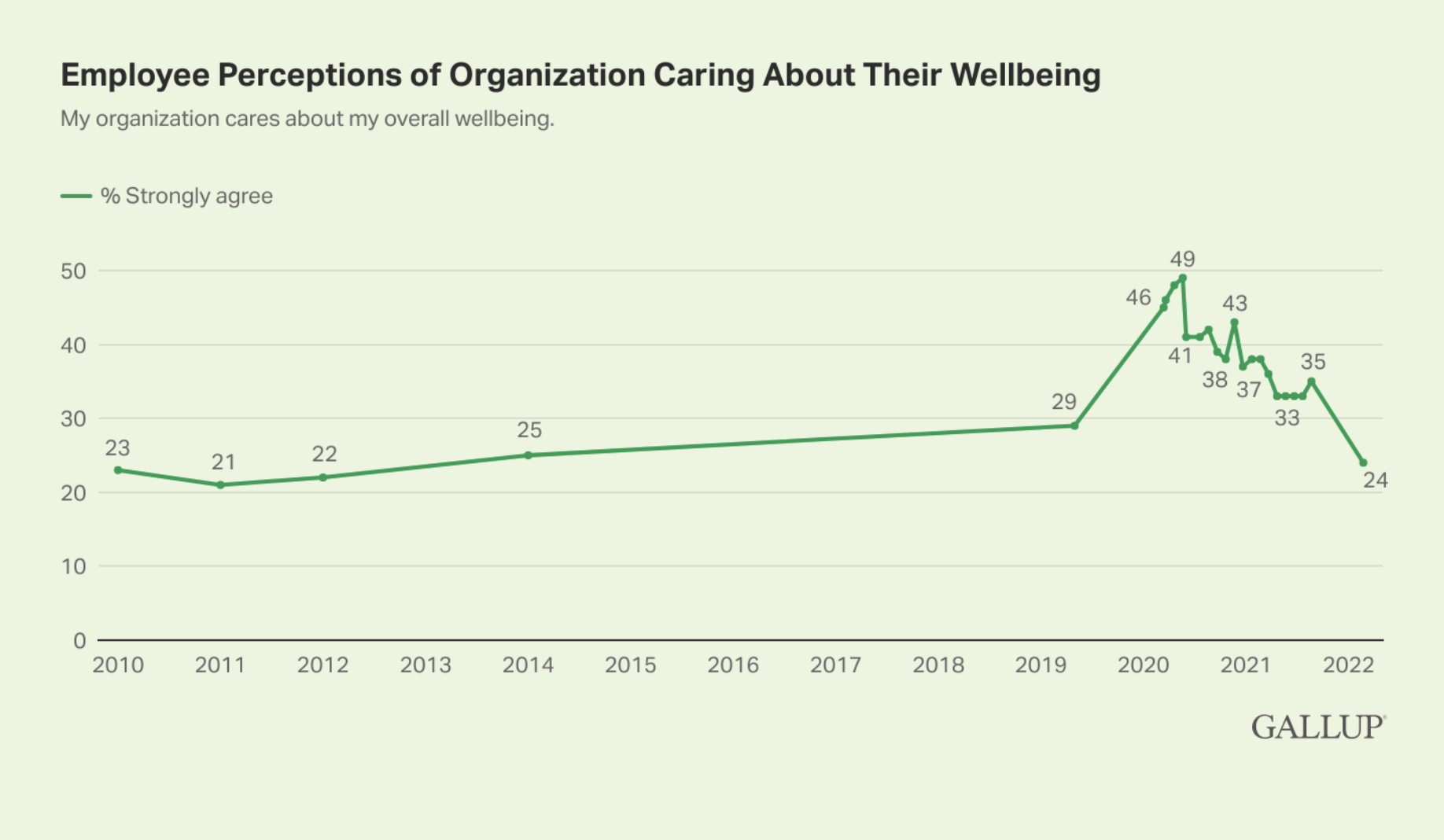Over the past few years, conversations regarding employee well-being have reached an all-time high. Employees’ wellness expectations have risen significantly, and many companies are increasing investments in wellness solutions to meet their needs.
Despite this, only 24% of workers strongly agree that well-being is cared about by their employers, according to a recent Gallup Poll.
This mismatch of data points calls for an explanation. With 35% employers investing more in wellness and 43% investing the same (because many feel their investment is adequate), why do so few employees believe their companies care about their well-being?
Potential Explanations
Employers must have a clear idea of what might be causing this problem before solving it. There are three potential explanations. Specifically, employees’ negative perceptions of their employer’s concern for their well-being might stem from:
- Beliefs they hold about the effects of their company’s policies and initiatives on their well-being
- A lack of awareness regarding their organization’s wellness initiatives
- Assumptions about their organization’s motivations for implementing a wellness program
Explanation #1: Beliefs About The Wellness Implications Of Organizational Policies
Near the beginning of the pandemic, when many employers were enacting plans to protect their workers’ well-being, Gallup found the percentage of employees who felt their employers cared about their well-being reached an all-time high, topping out at 49% in May of 2020.

It might be that the recent removal of some work arrangements (e.g., remote) that organizations implemented to protect their employees explains why they now feel that their well-being is less of a concern for their employers. As a result, many companies should avoid returning to the standard five-day, in-person workday and offer an alternative arrangement with added flexibility (e.g., hybrid work, four-day workweek, six-hour workday, split shifts, etc.).
Employers should also ensure they utilize a holistic approach to well-being. While a focus on physical health is essential, companies must provide tools for enhancing other dimensions of wellness (e.g., social, emotional, and financial wellness). Mental health resources are of particular importance as employees continue to experience symptoms of mental illness after the sustained period of heightened stress levels they endured during the pandemic.
To remove any uncertainty regarding the perceived utility of their wellness offerings, employers should survey their workers to precisely determine what they need to be well. Different organizations will have different wellness needs, and it’s important not to assume there is a one-size-fits-all solution. By learning directly from employees, employers can create tailored solutions that address the needs workers feel are most important.
Explanation #2: Lack Of Awareness Regarding Wellness Offerings
Offering solutions that are effective by employees’ standards won’t be enough if they aren’t aware of them. For example, an employee who cares most about mental health offerings may not believe their organization cares about their well-being if they don’t know they provide comprehensive mental health solutions.
To fix this, employers must communicate their offerings more effectively. Organizations should ensure they are providing benefits information through multiple communication channels. They must go beyond distributing employee handbooks and sending emails as many employees may not read them. For example, organizations can set up information stations in high-traffic office areas. Some experts recommend creating more engaging ways for employees to discover their benefits (e.g., a benefits scavenger hunt or a benefits quiz with prizes for those who complete it first).
Making sure the information has been heard is only half the battle. One study found that nearly 50% of employees feel they don’t understand the benefits that are offered. To offset this problem, employers should simplify their messages by getting rid of jargon and other complex terms that employees may be unfamiliar with.
Explanation #3: Assumptions About Their Organization’s Wellness Motives
Aside from feeling their company’s wellness program is ineffective, employees might not trust their organization’s motives for offering one. Some workers may believe their employers lack an intrinsic concern for well-being and are focusing on it to maintain a particular brand; cut down on health care costs; and achieve higher levels of productivity, engagement, and retention.
Some experts have argued that these perceptions can result in lower program satisfaction and commitment. Dr. Lisa H. Nishii, professor of organizational psychology at Cornell University, states:
When employees perceive that the intended goals of HR practices connote lower levels of concern for employees and a more cost-driven control-focus (i.e., cost reduction and exploiting employees HR attributions), lower levels of satisfaction and commitment are likely to ensue.
There are several measures that corporations can take to change the way employees feel about their reasons for implementing wellness initiatives. First, they must evaluate their actual motivations. While the impact of well-being on positive organizational outcomes is important, companies must value employee well-being for its own sake. If employers lack a genuine commitment to this value, employees will sense it.
Second, companies should avoid focusing on how well-being can improve organizational performance. While employees may want to be more productive, engaged, and eager to work for their organization, learning from their company that wellness results in these outcomes won’t give rise to positive perceptions of the program.
Another way of addressing this issue is through organizational culture. Different cultures are likely to make different assumptions about their organization’s reasons for implementing a wellness program. For instance, in competitive and profit-oriented cultures, employees are more likely to be suspicious of their organization’s motives than in collaborative and supportive cultures. As a result, companies running wellness programs must be mindful of the impact of culture on how employees view their attitudes toward wellness.
Takeaway
Perceptions employees hold about their companies caring for their well-being are unlikely to improve if workers feel their organizations have poor company policies and are offering wellness benefits for the wrong reasons. Even if employers address these concerns, they still may suffer from poor promotions. To improve employee feelings on this subject, businesses must:
- Care about employee well-being for its own sake and not because of its effects on organizational performance
- Avoid one-size-fits-all solutions and provide offerings that are tailored to their employees’ needs, with an emphasis on flexibility
- Raise awareness so that workers know of and understand the benefits that are available to them












